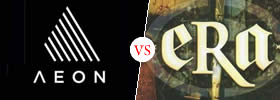Difference between Workgroup and Domain
Key difference: A workgroup is a type of peer-to-peer network. It is essentially the name for a Windows based peer-to-peer computer network. Computers in this kind of network can allow each other access to their files, printers, or Internet connection. A domain, on the other hand, is a client/server network in which the security and resource management is centralized. This means that a singular administration has control over the domain and allows which users have access to which files.
 Domains and workgroups are two different methods for organizing computers in a network. The main difference between the two is in the manner they operate, chiefly how the computers and other resources on the networks are managed.
Domains and workgroups are two different methods for organizing computers in a network. The main difference between the two is in the manner they operate, chiefly how the computers and other resources on the networks are managed.
A workgroup is a type of peer-to-peer network. It is essentially the name for a Windows based peer-to-peer computer network. Computers in this kind of network can allow each other access to their files, printers, or Internet connection. In order to do this, every user must have an account on each of the workgroup’s computers that they require access to. These settings and access are managed by each computer’s user.
A domain, on the other hand, is a client/server network in which the security and resource management is centralized. This means that a singular administration has control over the domain and allows which users have access to which files. In a domain, there is a one single database for domain users. A user can log on at any workstation via their account and access the files.
 Advantages of Domain over workgroup:
Advantages of Domain over workgroup:
- Centralized administration
- User can log on at any workstation and access domain resources.
- Security of data, user and groups
- Runs on Windows 2000 and 2003 Server or advance support for server configuration
- File, folder & user and group permission can be assigned.
A side-to-side comparison of workgroup and domain:
|
|
Workgroup |
Domain |
|
Network type |
Peer-to-peer Windows computer network |
Client/server network |
|
Log in |
User needs to have separate log in id and password at each workstation |
User can log on at any workstation via their account and access domain resources |
|
Workstations |
Computers are limited to maximum 10 |
There can be up to 2000 computers |
|
Administrator |
Each user controls the resources and security locally on their PC's |
One administrator to administer the domain and its users and resources. |
|
Location |
All computers must be on the same local network or subnet. |
The computers can be on different local networks, i.e. anywhere in the world. |
|
Computer's settings |
Each user controls the settings on their own computer. No central settings. |
One can make only limited changes to a computer's settings because network administrators often want to ensure consistency among computers. |
|
Changes |
Each computer must be changed manually or once changed must be transferred to each computer. |
Changes made to one are automatically made to all computers |
|
Security |
User needs to have separate log in id and password at each workstation, but once logged in can access the computer. |
Domain users must provide a password or other credentials each time they access the domain. |
Image Courtesy: spectorsoft.com, samba.org









Comments
chetan devre
Thu, 03/01/2018 - 23:00
Mohammad Sufiyan
Wed, 02/28/2018 - 16:08
Anonymous
Wed, 02/21/2018 - 20:17
Sameer Shahnawaz
Thu, 12/21/2017 - 20:03
Ranjeet Kumar
Mon, 12/18/2017 - 19:36
thank you
Tue, 11/28/2017 - 11:19
bikram dilu
Wed, 10/18/2017 - 20:05
teeboy
Tue, 04/19/2016 - 18:54
Thanks
Prashant Tiwari
Mon, 05/04/2015 - 10:52
Great...........
Roshan Singh
Fri, 02/27/2015 - 12:30
Pages
Add new comment